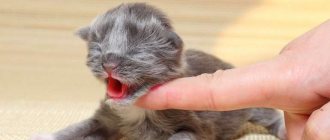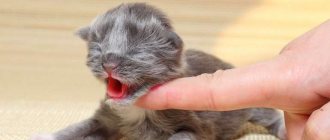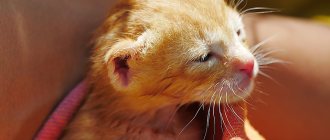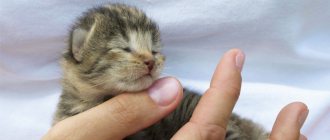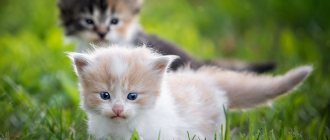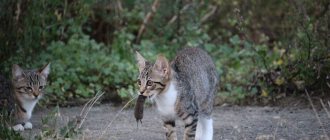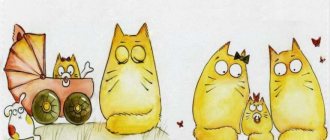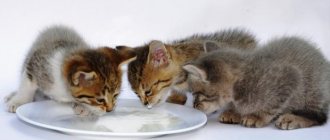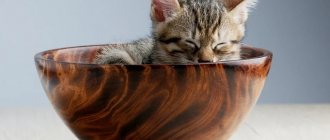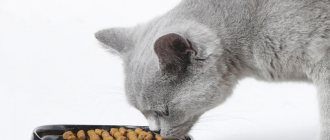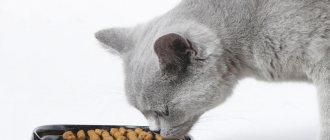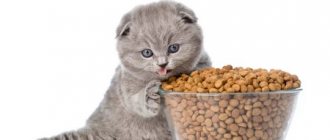Sometimes it happens that after the birth of kittens, a cat is unable to feed them breast milk on her own.
A milk replacer for kittens will help solve this problem. In this article we will tell you about the features of cat milk, help you choose a quality substitute, and also talk about its dosage and use. The article will also describe several recipes with which you can prepare replacement mixtures at home. This is useful if you do not have the opportunity to purchase ready-made formula in a store or order it online, and the kittens need to be fed urgently.
© shutterstock
Dishes for feeding kittens
You can feed kittens from bottles and syringes purchased at the pharmacy. Often, an ordinary disposable syringe without a needle is used for this purpose. The syringe must be replaced with a new one throughout the entire feeding period. Its lower end is sometimes rounded, treated with thin sandpaper or a file. Even in cases where the kitten initially does not immediately like this method of feeding, he will gradually get used to it and even begin to suck out the contents of the syringe.
A homemade device in the form of a bottle of used drops and a pipette is also suitable for feeding kittens. A bottle of eye drops, for example, chloramphenicol drops, is ideal. It resembles a baby bottle, and the top part is adapted for a nipple made from the rubber part of a pipette. Before use, all items are washed well and must be sterilized. Abandoned kittens have very weak immunity, so bottles and nipples must be sterilized and the syringe replaced with a new one.
Artificial feeding of kittens
If you do not know how you can feed kittens without a cat, and also do not have such experience, you should study this issue thoroughly before starting feeding, especially artificial feeding. The fact is that when feeding a newborn at the initial stage, many questions arise. For example, many people do not know that when feeding an animal with a pipette, you introduce very little mixture into its oral cavity, but at the same time the animal receives quite a lot of air. This is harmful for the kitten.
Experienced cat owners who know how to feed a kitten without a cat recommend using a 20 ml disposable syringe for this purpose. In this case, the loss of nutrient fluid will be minimal, and practically no air will enter his mouth. On such a syringe you will need to put a pipette tip, from which the babies will draw the artificial nutritional mixture, but you should not overdo it so that too much liquid does not get into the animal’s mouth.
Feeding formula should be stored in the refrigerator for no more than a day.
In addition, one of the basic rules of such feeding is the use of only fresh mixtures. This is written about in all the manuals that talk about how to feed a one-month-old kitten without a cat. The fact is that these animals, especially their younger generation, are very sensitive to the quality of food, so the feeding mixture must be stored in the refrigerator for no more than a day.
Feeding an animal with a hot formula is simply unacceptable due to the fact that this can negatively affect its health. Therefore, before each feeding, it is necessary to carefully check the temperature of the prepared food. It should be relatively warm.
Advice! The feeding procedure is best carried out when the animal is lying on its stomach, as this position is the most natural.
The feeding procedure is best carried out when the animal is lying on its stomach
. After you feed your pet, it is worth holding it vertically for some time so that the air comes out of the stomach, which will prevent it from bloating in the future.
Focus on the animal's behavior so as not to overfeed it. If it is sleeping, it means you have fed it enough, but if it is restless and moving, it is still hungry. In addition, after feeding, it is necessary to massage the kitten's belly to stimulate digestion. If you do everything correctly, your pets will gain weight equal to 100 grams per day.
What will you need for self-feeding?
To feed a small newborn kitten, you should purchase special equipment:
- A pacifier, but definitely not a baby one . You will need a special one, which can be purchased at a pet store or veterinary pharmacy. But the baby is fed without a pacifier; it will be needed a little later.
- Pipette . This is the best option for feeding the animal. Its convenience is that food can be served in doses and the volume can be clearly calculated. However, the pipette should be used carefully, since air entering it can cause severe bloating in the baby.
- Spoon - theoretically, a kitten can be taught to eat mixture from a spoon, but this method of feeding contributes to the suppression of sucking reflexes.
- Syringe – used without a tip (needle). This device is considered the most convenient and easy to use. The syringe's nose resembles a cat's nipple and helps develop conditioned reflexes.
Bottles. Pet stores sell special feeding bottles. However, they all have standard universal sizes, so they are not suitable for all breeds of kittens. Owners will need to select an individual size:
- When you turn the bottle over, milk flows out. This indicates that the hole diameter is too large. Intensely leaking milk threatens the kitten with choking.
- The milk comes out of the container only after pressing on it - the hole has an insufficient diameter, so the milk comes out with difficulty, because of this the kitten will not be able to suck it. Such inconvenience for the animal will lead to it refusing to eat.
- The ideal hole size is that the milk drips slowly when you lightly press the sides of the bottle.
It is important to immediately select the correct hole diameter for the kitten.
The animal will quickly get used to a certain type of nipple, and replacing it can lead to a complete refusal to eat from the bottle. It is difficult for a person to replace a mother cat for a newborn kitten. But if you put maximum effort and attention into the process, it will turn out very well.
Special feeding tube
This device is used if it is not possible to awaken the baby’s sucking reflex, accordingly, other methods of feeding are impossible, or the animal is too weak to suck on its own.
Using a special tube is the cleanest and most hygienic method of feeding kittens. But using this device requires a certain skill and extreme care. Disadvantages of using a tube:
- There is no way to control the amount of food, which is why the kitten receives too much of it (extremely bad for digestion) or, conversely, not enough.
- If the baby has a well-developed sucking reflex, but cannot satisfy it due to the lack of a pacifier or syringe, he begins to “suck” the fur of another kitten or his own. He does this too intensely, which can lead to serious skin diseases.
Algorithm for using the handset:
- Open your pet's jaw by pressing on it with your fingers. Before inserting the tube into the esophagus, it must be lubricated with a special product, for example, KY jelly.
- Hold the kitten's head straight while pushing the tube down the esophagus. You need to slide across the sky, moving the device along the back wall of the esophagus.
- The tube should be advanced until the mark on the hose is equal to the level of the nose - it has reached the esophagus.
- Connect a syringe with the nutritional mixture to the tube. It is recommended to press the piston slowly and carefully.
How to make a mark? The distance from the animal's nose to the last rib is measured. The mark is needed in order to insert the tube correctly, directly into the stomach.
Risk of improper use of the tube. You cannot use the tube without certain knowledge and skills. When deciding to feed a kitten with a special device, you must consult with a veterinarian who will demonstrate the correct use of this device.
Incorrect technique for using the tube carries the risk of it getting into the respiratory tract. If the kitten squeaks while feeding, it means that the tube has entered the stomach without touching the respiratory organs. Given the difficulty of tube feeding kittens, this method is mostly used by breeders.
What to feed a kitten
When purchasing a ready-made formula, in most cases, manufacturers also include a bottle with a nipple. Similar devices are sold in most pet stores or veterinary pharmacies. If you do not have this opportunity, you have to use improvised means :
- Syringe with needle removed
- A pharmaceutical pipette placed on a thoroughly washed medicine bottle
When piercing the pipette, make sure that the hole is not too big and that the little one does not choke. If the milk mixture regularly enters the baby’s respiratory tract, there is a risk of pneumonia.
Of course, it is much better to feed kittens with a designated nipple, satisfying their innate sucking reflex.
As in the case of artificial feeding of a child, and in the case of feeding a kitten, it is very important to maintain a clean process. All devices, after washing, must be boiled (sterilized).
Temperature and dose of milk
Depending on its size, the kitten is given approximately 2.5 milliliters of the mixture, adding half a milliliter evenly after two feedings. After three days, the baby is able to drink up to 10 milliliters of milk. The temperature of the mixture should not exceed 38-39°C. That is, the mixture should not be hot, nor should it be cold. You can check whether the formula is suitable for feeding a kitten by dropping it on your wrist. The warm mixture does not burn.
Often, when feeding, they adhere to the following regimen, depending on age: - 1 week - approximately 30 milliliters per 100 grams of weight; - at 2 weeks 35 milliliters per 100 grams of weight is given; - at 3 weeks the norm is 40 milliliters per 100 grams of weight; - from 4 weeks - ranging from 48 to 53 milliliters per 100 grams of weight.
Number of feedings
Feeding follows an approximate pattern:
| Kitten age | Amount of feed per feeding | Number of feedings per day |
| From birth to 1 week | 1.5 tsp. | 12 |
| 2 weeks | 2 – 3 tsp. | 6 |
| 3 weeks | 1 tbsp. l. | 3 |
| 4 – 5 weeks | 3 – 4 tbsp. l. | 3 |
| 6 weeks | 4 – 5 tbsp. l. | 3 |
How often are newborn kittens fed and how is the serving size determined?
In order for tiny babies to emerge, they will have to be fed every 2 hours, including at night. Two-week-old kittens can be fed every 3 hours during the day and once at night. Feeding three-week-old cats involves feeding them 4 times a day during the day; they are not touched at night. After eating, the kittens immediately fall asleep, and when hungry, they begin to squeak loudly and crawl around the box, poking their noses into the walls.
For the first five days after birth, kittens should eat 30 ml of the prepared mixture per 100 g of weight per day. Then the amount of food is gradually increased so that the daily norm is 38 ml/100 g. From the 15th day, every day the baby is given 45 ml/100 g of weight. This diet is maintained for the next 9 days, and then, for a month, the daily dose is 55 ml.
With a properly selected diet, the cat should regularly gain weight. If at the time of birth the baby weighs 90 g, then in the first week of life he should add 20 g, up to 110 g, and a week later - up to 190–200 g. In the third week, the baby’s weight should be at least 270 g. When does the kitten weigh a little less than 400 g, they begin to gradually introduce complementary foods.
Procedure
Having prepared the mixture, do not forget that the feeding procedure itself must be properly prepared. When feeding a newly born kitten, it is carefully picked up. Lightly placing a purchased or home-made pacifier into the baby's mouth, support it at an incline of 45. If the baby suddenly coughs, you should turn him head down so that he does not choke.
© shutterstock
Experienced cat owners advise that while feeding, gently and lightly stroke the kitten on the head and, if possible, imitate the calm purr of a nursing cat. According to many breeders, such actions have a very beneficial effect on babies. When a kitten is left without its mother, a cat, it is more sensitive to affection and living warmth.
A well-fed kitten can be identified by the milk remaining on its face and round tummy. Milk “gurgles” coming from the baby’s mouth also indicate saturation. In addition, a well-fed kitten stops sucking the formula and falls asleep.
After the feeding procedure is completed, wipe the kitten’s face and any soiled parts of the baby’s body with a cloth soaked in warm water, preventing the mixture from drying on the fur. Such care is mandatory for hygiene.
Feeding kittens
In order for babies to develop normally, they need a proper diet with the obligatory presence of vitamins. To create mixtures for kittens, you should get a small measuring cup. You also need to know how much weight of a particular component a teaspoon or tablespoon can hold. This knowledge will be useful when preparing mixtures.
All kitten formula recipes include dairy products. At best, food that replaces cat milk is purchased at pharmacies and pet stores. However, this option is not always suitable for everyone. Therefore, people use self-created mixtures to feed kittens.
To create a milk formula for a kitten, goat's milk with a fat content of up to 2.5% or cow's milk - 1.5% is often used. Once every 2 days, you can add the yolk of quail eggs and 2-3 drops of syrup consisting of 1 teaspoon of water and 1 teaspoon of sugar to the milk.
When the kittens open their eyes, they should be given any meat mixture intended for human children. At first, it replaces one milk feeding. A day later another one and so on.
The meat mixture (2.5 ml) should be diluted with one teaspoon of water, stirring until it becomes liquid sour cream. Kittens are fed through a syringe or pacifier. The solution is stored in the refrigerator for 24 hours.
Feeding regimen and rules
Overfeeding is just as bad as underfeeding; in order not to make mistakes, you need to know the norms for the required quantity and frequency of food intake. Formulas and milk are calculated based on weight and age. Weight gain is considered a sign of proper feeding.
For a kitten up to two weeks old, the dose is divided into 24 hours. Gradually, the frequency of snacks decreases, and portions increase. Older pets are transferred to daytime feeding.
Recommendations for feeding kittens:
- You cannot give a kitten the same thing as an adult cat, much less a human.
- There is no need to add dry food as complementary foods.
- You cannot add vitamins to the finished mixture; there are enough of them.
- All new products should be introduced gradually and in small doses. If no pathological manifestations are found after 24 hours, the product can be given to the kitten.
- The kitten should always have access to clean water.
- You need to give food as much as the baby requires, the norms are indicated for most kittens, but there is no need to force feed or starve the kitten.
How and what should newborn kittens be fed?
Feeding helpless newborn kittens is the most crucial moment in care. An undeveloped digestive system requires a serious approach to choosing formula milk. In the first days of life, the cat feeds the babies colostrum, which will ensure the development of primary immunity. Cats cannot do without it, but in a veterinary clinic they can inject a special serum subcutaneously. It is made from cat blood and contains all the necessary substances that protect babies from viruses and harmful bacteria.
Experts recommend feeding newborn babies frozen milk from another cat, but this option is not always available. You cannot feed them cow's milk, because it does not contain the necessary proteins and amino acids. With such a diet, kittens begin to get sick and quickly die. Cat milk has a unique composition; it contains a lot of taurine and fats. It can only be replaced with specially developed mixtures for cats.
Ready-made milk formulas - cat milk substitutes (brands, composition, price)
Feline formula is produced by different manufacturers. It is adapted for babies, does not cause allergies and contains all the substances necessary for a small body.
Each package contains a convenient bottle, preparation instructions and a description of the composition. The product is sold in large plastic jars weighing 200, 300 or 500 g, inside which are placed 3 bags of formula, several nipples, a bottle and a measuring cup. The most popular manufacturers of such cat food on the world market are Beaphar. The first produces the “Babycat Milk” mixture, and the second – “Kitty Milk”.
Both products have a similar composition and contain:
- protein;
- minerals;
- taurine;
- amino acids;
- vitamins;
- antioxidants;
- fats;
- fiber.
For a jar of “Kitty Milk” weighing 200 g you will have to pay from 640, 500 g – from 1300 rubles, and the “Babycat Milk” mixture (300 g) will cost the owner from 1200 rubles. There is a mixture with the addition of German maternal colostrum "Kittenmilch", its cost is from 1200 rubles for a package weighing 90 g and from 4860 for 750 g. How much cat milk substitute is needed for 21 days (after three weeks babies can be fed), depends on the recommendations on its application.
Dosage when feeding kittens with milk replacers
The finished mixture must be measured correctly; for this, for example, manufacturers of some mixtures include in the packaging a special measuring spoon and three nipples of different sizes for the convenience of feeding the animal as it grows.
Savannah kittens are among the tallest
When and in what dosage is it best to feed a kitten?
First of all, it all depends on his age and breed. Kittens of large breeds, say, Maine Coon, Norwegian Forest Cat, Kurilian Bobtail, Pixie Bob, Ragdoll, Turkish Van, are much larger physically than their counterparts. Accordingly, their need for nutrients for normal development is higher.
Packages of milk substitutes from different manufacturers must contain an approximate calculation of the dosage. The amount of mixture required looks like this:
- From one to four days - 30-32 ml;
- From five to fourteen days - 37-39 ml;
- From fifteen to twenty-five days - 44-47 ml;
- From twenty-six to thirty-six days 52-55 ml.
You need to monitor your pet's weight gain every day.
To calculate the exact dosage of the diet your kitten needs, you need to monitor your pet's weight gain and health status every day. You can learn more about this based on the table:
Cat milk replacer dosage table
Although the table provides complete information about the dosage, it is necessary to determine as accurately as possible whether the kitten is full or not. This is necessary because both overfeeding and underfeeding are dangerous for his body. If the cub is underfed, it falls into a state of lethargy and restlessness. If, on the contrary, it is overfed, the animal’s stool changes. Stool is the most obvious indicator of a cat's satiety. Light overfeeding leads to loose, yellowish stools.
With average overfeeding, the stool becomes greenish, and with regular overfeeding, the stool becomes gray.
Kitten formula recipes
1. In a liter of boiling milk, stir 1 teaspoon of bone meal, 200 milliliters of condensed milk without sugar and 100 milliliters of water. The resulting mixture is filtered and cooled.
2. Mix 2 egg yolks, a glass of milk, 1 teaspoon of vegetable oil, 1 drop of Tertravit or Trivit vitamins.
3. Use 0.5 teaspoon of unrefined vegetable oil as an additive, “Tertravit” up to 0.3 milliliters, “Vitom” - on the edge of a knife. Without additives, the mixture can stand in a cold place for 24 hours. When additional components are added to half the solution before feeding, the mixture is filtered through a sieve and heated in a sterile container immersed in warm water.
4. Goat or cow's milk is mixed with protein in a ratio of 4 to 1 and whipped until smooth.
5. Mix 50 ml of raw and 50 ml of boiled milk, 0.5 yolk and 1 tsp. corn oil.
6.1 egg yolk, 0.5 l. concentrated milk is mixed until smooth.
7. 200 ml of cream with 10% fat content is diluted with water 1:2. A glass of 10% cream should be diluted with boiled water in a 1:2 consistency.
8. For weak babies, the mixture is prepared from half a glass of milk with a fat content of 3.2%, 20 ml of glucose (5%) and 1 yolk.
What else is needed to feed kittens?
After you have learned how to feed a kitten without a cat, it is also worth getting an idea about caring for it during the feeding period. So, for this you need to perform the following manipulations:
- make a heated nest for your charges;
- ensure hygiene in it;
- ensure the removal of waste directly from animals.
The temperature of the nest for a kitten should correspond to 38 °C.
As for the nest, its temperature should correspond to the average temperature of a cat - 38 °C. The thing is that the first 2 weeks of life require creating an increased temperature for kittens, which is generated by a cat under normal conditions. In order to achieve this effect artificially, it will be necessary to make a nest for them from baby diapers or fabric. To maintain the optimal temperature in it, you need to put an electric heating pad, a hot water bottle or a regular heating pad in it.
It is best to wrap the heating pads and bottle in a rag or towel. As for hygiene, it is worth periodically making a new nest and throwing away the old one. To prevent waste from spreading across the floor, it is necessary to place the nest in a basin; it is best not to use a paper box for this purpose.
Nursing kittens should be protected from drafts
Hygienic procedures must also be taken for the animals themselves. The fact is that in nature, kittens are cleaned by the mother cat. With artificial feeding, for obvious reasons, a person must take over its functions. This can be done using a special cloth glove. Until the animals grow up, it is better not to bathe them.
Important! Breastfeeding kittens must be protected from drafts, so when cleaning the nest they must be placed in a warm place, sheltered from the wind.
In addition, be sure to give your babies something to drink, unless, of course, there is a large amount of moisture in the nutritional mixture. Only by performing all procedures carefully and on time, you will be able to raise healthy and beautiful kittens, which over time will become your pets.
Cat milk replacer
There is no natural alternative to cat milk, which is not surprising from the point of view of nature itself. But wise, caring manufacturers have already learned to create mixtures that are safe to replace cat milk. Even if not to the fullest extent, it is better than nothing. The most important thing is that the products contain vital components for the kitten:
- vitamins and minerals;
- amino acids;
- fatty acids (Omega-3 and Omega-6);
- microelements.
There are more than three dozen manufacturers of artificial cat milk in the world, whose products differ in composition, quality and, accordingly, cost. The most famous brands (some of them also produce food):
- Royal Canin;
- Beafar;
- Kamon;
- Nutri-Wet;
- Dolphos;
- Clouders;
- Jimborne;
- Trixie;
- Harts;
- Vo-Toys;
- Jimpet.
Unfortunately, having taken on such a responsible task, many manufacturers have not been able to recreate the formula of cat milk as accurately as possible. They overlooked many ingredients, without which the correct development of the cat could be in jeopardy. But the products “Royal Canin”, “Beafar” and “Gimpet” have established themselves as the most complete mixtures in terms of ingredients. In addition, the three named products replicate the proportion of nutrients contained in real cat milk.
For which breeds - which substitute?
Cat milk replacers are universal not only for all cat breeds, but also for most young pets in general. For example, many owners give a mixture of the same manufacturer to both kittens, puppies, and ferrets. The main difference when feeding is the breed for which the replacement is needed. The larger the kitten, the more nutrients it needs. Of course, the dose must be increased very carefully, because the pet’s stomach is very small in the first weeks. You should also monitor the color of the feces and whether the kitten falls asleep after feeding.
Source
Frequency of feeding
During the first week, babies are fed every 2-3 hours during the day to avoid various diseases and to strengthen the body. Then gradually reduce feeding at night, bringing the feeding interval to 5 hours in the second week. At week 3, when the kittens begin to see, feeding at night is stopped (from 24:00 to 6:00 am). After 4 weeks, they proceed to the feeding process according to the usual schedule.
We invite you to familiarize yourself with: Bengal cats - photos and descriptions of the characteristics of the breed
The kitten may refuse further food intake due to the fact that he generally eats little. Sometimes this is associated with some kind of disease. If you have any doubts, consult your veterinarian.
If the baby's tummy is large and dense, you should stop feeding after feeding the required portion. The animal may not feel full and therefore continue to eat.
Raising kittens without a cat is a completely accessible process for any compassionate person. Very little time will pass and the result will be a playful mood and a healthy appearance for your grown-up pet.
Why do cats abandon kittens?
Despite the fact that cats usually have a stronger maternal instinct than dogs, they still sometimes abandon their kittens. The question of how to feed a blind kitten without a cat may arise primarily because the cat may refuse to feed it due to the poor psychological climate around it.
If you make noise near the lambing area, the animal will get scared and abandon the kittens.
In a normal state, from the moment the kittens are born, the animal begins to take care of them, namely, licking them and feeding them milk. If in the first days you fuss too much around the family or make noise near the lambing area, the animal will simply get scared and abandon the kittens. This can also happen when you occasionally pick up kittens in your arms without the animal’s permission. It’s one thing when the owner does it, it’s another thing when strangers do it.
There should be no contact with them until the kittens open their eyes. Typically, such a quarantine lasts several weeks, and the optimal situation will be when the cat itself brings the kittens to you, or they start running on their own and come out of their hiding place. In all other cases, only the owner of the animal in emergency cases, or a veterinarian, can examine and touch the family.
When a cat does not have milk in the first days after giving birth, you will have to feed the kitten yourself
It is worth knowing that when kittens are born by caesarean section, the cat’s maternal instinct is often weakened. As a result, you should take care in advance about how to feed a kitten without a cat. The same measures should be taken when the cat does not have milk in the first days after birth. This may be due to a hormonal imbalance that she experienced. In the latter case, a little later the animal can take the kittens back for feeding.
In addition, the animal may get sick or may not like the place where the offspring is located. In this case, the cat will begin to drag it to a new place, which will also affect its desire to feed. Therefore, if you do not know whether it is possible to feed a kitten without a cat, it is best to clarify this information in advance. If you are prepared, the newborn animal will quite calmly endure the procedure of artificial feeding without harm to its development and condition.
You can negotiate with the owner of a nursing cat and give her kittens
It is also worth looking very carefully at the entire lambing immediately after birth. Unfortunately, sometimes sick and dead kittens are born. You will need to get rid of them immediately, since the cat’s hostility towards them can spread to healthy kittens, which she may stop feeding. Sick kittens are treated, but defective ones, unfortunately, will have to be euthanized.
Prohibited Products
It is recommended to feed the kitten only with approved products; you cannot experiment. It is strictly forbidden to give your baby:
- Undiluted cow's milk . It is very heavy and difficult to digest, especially by the unformed digestive tract of a newborn kitten. Feeding your pet cow's milk will lead to severe indigestion, from which he may die.
- Cream is an extremely harmful product for a kitten’s digestive system and overall health.
- High fat dairy products . The higher the percentage of fat content in a product, the greater the impact on the liver and the risk of developing indigestion.
- Premature feeding with meat and sausages . The kitten, of course, will like the smell and taste of meat, but its gastrointestinal tract is not able to digest heavy food. The consequences of such complementary feeding can be extremely disastrous.
If you have to independently feed a kitten deprived of its mother cat, it is best to consult a veterinarian.
Piece feeding
In principle, it is not difficult to feed a kitten that has lost its mother on your own. If you approach feeding correctly and follow the advice of more experienced specialists.
© shutterstock
First of all, you should remember that milk from a cow, based on the amount of certain components, is absolutely not suitable for feeding a kitten. So, if the level of water, lactose, fat and ash in cat and cow milk is almost the same, then if the protein in cat milk is 7.0, then in cow milk it is only 3.3%.
The best option for feeding a newborn kitten without a cat is to purchase a ready-made powder substitute. It could be :
- Royal Canin Baby Milk
- Kitty Milk
If you don’t have a veterinary pharmacy near you or don’t have enough money to buy one, you can prepare formula and feed newborn kittens yourself.
Sterilization and hygiene
Pacifiers, syringes, bottles and other feeding devices should always be sterilely clean. After each feeding, the syringe or pipette, pacifier, milk container must be properly processed. Rinsing with hot water is not enough to clean dishes.
The ideal option is to use a special steam sterilizer. It is sold in pharmacies in children's products. You can use pharmacy sterilizing liquids. After using them, the dishes must be rinsed under warm water. The use of dishwashing detergents is strictly prohibited.
Also watch the video on how to feed a newborn kitten without a cat:
Selection of cookware
An inexperienced person can make serious mistakes when feeding a four-legged orphan. When offering your pet a commercial formula, it is not advisable to use a bottle intended for infants. The ideal option is a bottle from a pet store. It is possible to use a children's accessory provided that the hole is tiny. Before offering the animal a treat, lower the bottle with the nipple down and apply light pressure. A white substance should slowly drip from the hole. If it pours out before pressing on the bottle, the hole is wider than necessary. Using such “treacherous” utensils is risky. Otherwise, the little kitten is in danger of choking.
Some breeders use a pipette to feed their pets. Take the risk of following their example. Sometimes housewives inject liquid into the animal's mouth using a syringe.
To protect the kitten from intestinal infection, the owner must wash the pacifier after each feeding, then pour boiling water over it.
An “infant” diet is relevant for an animal in the first weeks of life. At 2 months, a stronger pet is allowed to give beef, chicken, low-fat cottage cheese, and boiled vegetables.
How to organize feeding
To feed a kitten without a cat, it is important to follow the dosage of the mixture and the regimen. For the first month of life, he requires daytime and nighttime meals. This is due to the fast metabolism and small stomach volume.
Veterinarians advise adhering to the following rules:
- For the first two weeks, babies are fed up to 12 times a day. The break between meals is 1.5 - 2 hours. You will have to get up to see your pet at night.
- Over the next 10 days, gradually increase the interval between feedings to 2-3 hours. At night you will have to feed the animal 2 or 3 times.
- At 4-5 weeks of life, a kitten can easily go without food for 3 hours. At night, one feeding is enough for him.
In addition to the frequency of feeding, the amount of formula eaten is also important for the full development of the pet. It is calculated based on the baby’s weight. The average standards are:
From birth and the first 5 days, the daily volume of the mixture is 30 milliliters per 100 grams of weight.
- From 6 to 15 days of life - 38 milliliters per 100 grams of weight.
- From 16 to 24 days of life, the amount of the mixture is increased to 45 milliliters per 100 grams of weight.
- From 4 weeks into the next month, the volume of food is increased to 55 - 58 milliliters per 100 grams of weight.
Experienced breeders recommend diluting the feeding mixture with a little more water. This will prevent your kitten from becoming constipated.
What you need
It is better to feed a newborn kitten from a special bottle with a nipple. They are sold in veterinary pharmacies and pet stores. The bottles have special risks for more precise dosing of the volume of the mixture. And the nipples on them have an anatomically convenient shape for the animal. Their sucking imitates the sucking of a cat's nipples.
A temporary replacement will be a pipette. With its help, the pet receives small portions of the mixture; it is convenient for him to swallow them. But there is a high risk of a large amount of air getting into the kitten’s stomach. What causes digestive problems.
An alternative to special bottles is a regular syringe without a needle. During feeding, a volume of liquid equal to one division is squeezed into the kitten’s mouth.
It is important to regularly wash and sterilize feeding equipment. This is the key to your pet's health.
After each feeding, equipment is washed and then sterilized. For this purpose, steam sterilizers are used to disinfect baby bottles and pacifiers.
Special solutions for cold sterilization and containers for them are also suitable. After soaking in them, the bottle, pacifier or syringe is washed with boiled water.
It is possible to boil feeding equipment unless the manufacturer prohibits it. Sterilized equipment is placed on a clean towel and covered with paper napkins or a clean textile napkin. It is acceptable to store a bottle, pacifier or syringe in special containers designed for baby supplies.
Step-by-step instruction
Feeding a newborn kitten takes about half an hour. It is important that nothing distracts you during this time. The algorithm of actions is as follows:
- Wash your hands with soap.
- Prepare the mixture. Or reheat leftovers from a previous feeding in a cup of warm water. You should not heat milk in the microwave, as it warms up unevenly, creating too hot and cold areas.
- Sit comfortably and place a terry towel on your knees.
- Place the kitten on its stomach, paws down, head slightly raised.
- Squeeze a drop of the mixture onto the nipple or tip of the syringe and bring it to your pet's mouth. He will instinctively reach for them.
- If the kitten does not latch onto the pacifier, gently insert it into his mouth. He will start sucking on his own. If this does not happen, stroke his back and forehead.
- Hold the bottle at a 45° angle.
- When the pet attaches itself to the syringe, slowly squeeze out a small portion of the mixture (one division). Give the animal time to swallow it. Then squeeze out the milk again.
- Too much mixture in your pet's mouth is dangerous for his life. There is a high risk that he will choke.
- After feeding, hold the kitten upright to burp.
When the baby is full, he will turn away from the pacifier or syringe. A well-fed pet purrs and falls asleep. A hungry pet squeaks and looks for a pacifier.
Procedures immediately after feeding
After eating, kittens defecate. This process is stimulated by the mother cat by licking her butt and genitals. In her absence, the owner will have to take on this responsibility.
Soak cotton wool in boiled water. Wipe your pet's butt and genitals, imitating a licking motion.
After the kitten defecates, clean up the excrement. Then wipe his anal area with a clean, damp cotton swab. After you have completely wiped away any remaining stool, wipe your pet’s bottom with a damp cotton swab again.
Important points related to feeding
In addition to the daily amount of formula or the frequency of feedings, there are several more nuances of feeding kittens without a cat.
During the first 14 days, attention is paid to the weight of the animal. Veterinarians recommend weighing your pet every day. A kitchen scale is suitable for this. Remember to wipe them with a damp cloth or sponge before and after weighing.
Keep a diary to track your weight gain or loss. If there are sudden changes or a rapid decrease, contact your veterinarian.
The temperature of the mixture you feed the kitten is also important. Adhere to the following standards:
- The first 7 days of life – 38°C.
- From 8 to 14 days of life – 30°C.
- From 15 to 21 days of life – 28°C.
- From 22 to 30 days of life – 24°C.
Make sure your kitten is always warm. Its digestion is to some extent dependent on body temperature. If your baby is cold, food is digested more slowly. In the case of the mixture, this leads to its fermentation, which causes digestive problems.
Your psychological attitude is also important. Stay calm and be patient. Your anxiety will be passed on to your pet. And it is difficult to feed a kitten that is anxious and trying to slip out of your hands.
Some veterinarians recommend introducing vitamins into the diet of bottle-fed animals. They are produced in liquid form. Admission is acceptable from 2 weeks of age of the animal.
How to transition a kitten to solid food
A gradual transition to solid food begins when the pet is 4 weeks old. First, one feeding is replaced with food. Then its share is gradually increased.
To wean the kitten from the formula, he is offered wet food. If the pet does not show interest in it, add one or two tablespoons of the mixture to the food. This will give the food a familiar smell to the animal and make it more liquid and soft.
Make sure your pet always has food in his bowl. This will give him the opportunity to come up and try new food at any time. Which will make weaning from the formula faster.
Veterinarians recommend that the kitten be completely self-feeding by 7 weeks. At the same time, he must eat six times a day.
What to feed a one-month-old kitten without a cat
A one-month-old kitten should be transferred to self-feeding. At the same time, the owner must decide on the kitten’s future diet, whether it will be ready-made industrial food or natural food.
You can start teaching a kitten to eat liquid food from a bowl first, and then solid food, at 3 weeks, when the baby’s eyes are already open, he hears well and moves independently.
How to train a one-month-old kitten to eat on its own
When teaching a baby to feed independently, proceed as follows:
- The milk mixture is poured into a saucer and the cat is brought to it.
- Dip your fingers in the mixture and let the kitten sniff and lick them.
- If the kitten does not immediately understand what to do, scoop up a small amount of the mixture with a teaspoon and drip it onto the kitten’s tongue.
It is quite possible that the kitten will not start eating on its own on the first try - if the owner shows gentleness and patience, he will definitely do this.
Video: first feeding of kittens
Natural food
When feeding a kitten with natural food, each new product is introduced once every 3 days in order to track the baby’s body’s reaction to an unfamiliar product . It is important to immediately accustom the kitten to a varied diet in order to prevent it from avoiding any types of food that are healthy for it in the future.
To feed a one-month-old kitten use:
- very liquid porridge cooked in milk or meat broth from: buckwheat;
- millet cereals;
- rice;
- lean beef;
- kefir;
Ready-made feed
From ready-made food, choose products for kittens from reputable manufacturers. Baby foods are otherwise called starters.
Dry food for a kitten must be the best, and such products are never sold in grocery stores, and their advertisements are not shown on TV. These foods can only be purchased at veterinary pharmacies or specialized pet supply stores. It is very good if your veterinarian can help you with the choice of dry food.
Solid complementary foods are introduced when the kitten can already eat liquid food from a saucer.
The following are considered good manufacturers of kitten food:
- Orijen;
- Josera;
- Arden Grange;
- Purina Pro Plan;
Expensive dry food for kittens is a balanced diet enriched with vitamins and minerals
- Eukanuba;
- Royal Canin.
Food is offered to the kitten when he can already lap up the milk mixture from a bowl, and the granules must be soaked in it. As the kitten grows, the amount of formula in the food is reduced so that by the age of 8–10 weeks he can eat completely dry food.
Manufacturers also produce wet food for kittens and offer to combine them with dry food.
Both when feeding with prepared food and with natural nutrition, the kitten must have free access to clean drinking water.
What not to feed a one-month-old kitten
A small kitten should not be fed:
- leftover food from a person’s table;
- products containing spices, salt, sugar;
- expired, spoiled food and rancid food;
- sausages, smoked meats;
- fish with bones not removed;
- raw meat and fish;
- pork in any form;
- fatty foods;
- chocolate and cocoa;
- citrus fruits, peaches and grapes;
- legumes
Video: when and what to feed small kittens
Milk replacers and formulas for feeding two-week-old kittens
The ideal option for feeding two-week-old kittens are milk substitutes and formulas made taking into account the needs of babies. Cat milk replacers have lower fat and calorie content than cow's and goat's milk, but contain more protein.
The daily intake of formula for a kitten is calculated by weight:
- From birth to 7 days – 30 ml per 100 g. body weight.
- From 7 to 14 days – 35 ml per 100 g. body weight.
- From 14 to 21 days – 40 ml per 100 g. body weight.
- From 21 to 28 days – 45–48 ml per 100 g. body weight.
- From day 28 – at least 50–53 ml per 100 g. body weight.
Important! The daily intake of formula for a kitten may vary if whole milk or formulas based on it are used for feeding.
Industrial cat milk substitutes
Industrial cat milk replacers are available in powder form, which is diluted with water. The mixture is diluted before each feeding. In order for the kitten to eat the mixture more actively, its temperature should be close to 38 degrees.
The following milk replacers can be used to feed two-week-old kittens:
- Katzenmilch – possible from day one.
- Hartz milk powder.
- Babycat Milk (Royal Canin) - according to the instructions, it is possible only from 2 months, but the mixture can be used earlier if there are no alternatives.
- Beaphar Kitty-Milk.
- Gimpet Cat-Milk.
- Nutri Vet.
- Just Born.
- Nurturall-C.
- Pet Lac.
In small communities, purchasing an industrial cat milk replacer can be a problem. In this case, it is much more important to maintain consistency in the type of nutrition. If you are not sure that you will be able to purchase a milk replacer throughout the entire feeding period, it is better to immediately switch two-week-old kittens to infant formula or nutritional formulas based on whole milk.
Baby formula
It is recommended to use infant formula for kittens from two weeks of age. Naturally, milk formulas designed for children have a higher fat content and contain more milk sugar, which is not entirely acceptable for feeding a kitten.
The following infant formulas are usually used to feed two-week-old kittens:
- Nutrilon.
- Nestozhen.
- Little Istrinsky.
- Baby.
Important! Carefully monitor the condition of the babies; the slightest bloating, diarrhea, signs of an allergic reaction and other alarming symptoms indicate the need to urgently change the formula.
Scott's mixture for kittens - recipe, preparation, storage
Scott's kitten formula was invented before the advent of cat milk replacers. Below is a recipe calculated for 1 kg of weight, so be careful with dosages. Also, the original recipe calls for cow's milk, but for kittens it is better to use whole goat's milk.
Recipe:
- Homemade, not separated cow's milk – 50 g.
- Powdered milk – 15 gr.
- Dry yeast (nutritional) – 3 gr.
- Chicken egg (yolk and white) – 50 gr.
- Chicken egg white, beaten until foamy – 50 g.
- Sunflower oil, refined – 1 gr.
- Glucose (powder or pharmacy) – 4 g.
Preparation:
- Place all ingredients in a ceramic bowl.
- Mix the mixture thoroughly with a whisk until a homogeneous mass is formed.
- Using a syringe, take out the required amount of the mixture.
- Warm the mixture to 38 degrees before feeding.
The mixture is stored in a refrigerator in a ceramic container covered with cellophane and paper. Shelf life no more than 3 days!
Tiling mix
Tylinga kitten mixture is easier to prepare and lasts longer in the bottle because it does not contain yeast. Vitamin supplements can be purchased at a pet store. The only caveat is that industrially produced vitamin supplements are intended for kittens older than 1–2 months. Vitamin supplements must be ground to a powder and dosed by weight.
Recipe:
- Homemade, not separated cow's milk – 25 g.
- Powdered milk – 5 gr.
- Glucose (powder or pharmacy) – 2 g.
- Vitamin supplements for kittens (industrial) – 1 g.
Preparation:
- Place all ingredients in a ceramic bowl.
- Mix the mixture thoroughly with a whisk until a homogeneous mass is formed. If vitamin supplements are in tablet form, they need to be crushed into powder. To make the powder dissolve better, you can shake it better in heated milk.
- Using a syringe, take out the required amount of the mixture.
- Warm the mixture to 38 degrees before feeding.
The mixture is stored in a refrigerator in a ceramic container covered with cellophane and paper. Shelf life no more than 3 days!
